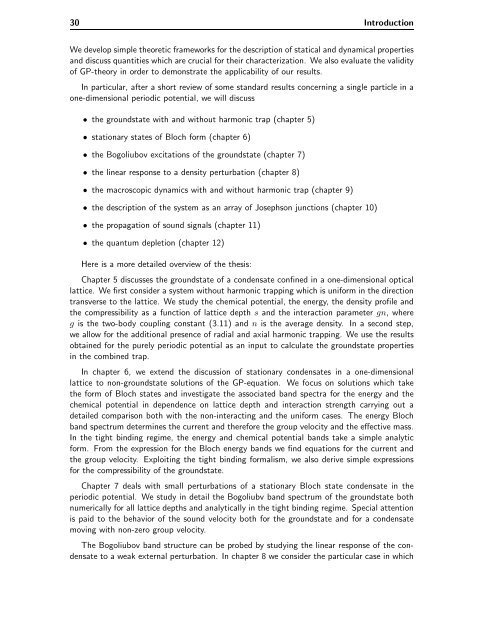Bose-Einstein Condensates in Rotating Traps and Optical ... - BEC
Bose-Einstein Condensates in Rotating Traps and Optical ... - BEC
Bose-Einstein Condensates in Rotating Traps and Optical ... - BEC
You also want an ePaper? Increase the reach of your titles
YUMPU automatically turns print PDFs into web optimized ePapers that Google loves.
30 Introduction<br />
We develop simple theoretic frameworks for the description of statical <strong>and</strong> dynamical properties<br />
<strong>and</strong> discuss quantities which are crucial for their characterization. We also evaluate the validity<br />
of GP-theory <strong>in</strong> order to demonstrate the applicability of our results.<br />
In particular, after a short review of some st<strong>and</strong>ard results concern<strong>in</strong>g a s<strong>in</strong>gle particle <strong>in</strong> a<br />
one-dimensional periodic potential, we will discuss<br />
• the groundstate with <strong>and</strong> without harmonic trap (chapter 5)<br />
• stationary states of Bloch form (chapter 6)<br />
• the Bogoliubov excitations of the groundstate (chapter 7)<br />
• the l<strong>in</strong>ear response to a density perturbation (chapter 8)<br />
• the macroscopic dynamics with <strong>and</strong> without harmonic trap (chapter 9)<br />
• the description of the system as an array of Josephson junctions (chapter 10)<br />
• the propagation of sound signals (chapter 11)<br />
• the quantum depletion (chapter 12)<br />
Here is a more detailed overview of the thesis:<br />
Chapter 5 discusses the groundstate of a condensate conf<strong>in</strong>ed <strong>in</strong> a one-dimensional optical<br />
lattice. We first consider a system without harmonic trapp<strong>in</strong>g which is uniform <strong>in</strong> the direction<br />
transverse to the lattice. We study the chemical potential, the energy, the density profile <strong>and</strong><br />
the compressibility as a function of lattice depth s <strong>and</strong> the <strong>in</strong>teraction parameter gn, where<br />
g is the two-body coupl<strong>in</strong>g constant (3.11) <strong>and</strong> n is the average density. In a second step,<br />
we allow for the additional presence of radial <strong>and</strong> axial harmonic trapp<strong>in</strong>g. We use the results<br />
obta<strong>in</strong>ed for the purely periodic potential as an <strong>in</strong>put to calculate the groundstate properties<br />
<strong>in</strong> the comb<strong>in</strong>ed trap.<br />
In chapter 6, we extend the discussion of stationary condensates <strong>in</strong> a one-dimensional<br />
lattice to non-groundstate solutions of the GP-equation. We focus on solutions which take<br />
the form of Bloch states <strong>and</strong> <strong>in</strong>vestigate the associated b<strong>and</strong> spectra for the energy <strong>and</strong> the<br />
chemical potential <strong>in</strong> dependence on lattice depth <strong>and</strong> <strong>in</strong>teraction strength carry<strong>in</strong>g out a<br />
detailed comparison both with the non-<strong>in</strong>teract<strong>in</strong>g <strong>and</strong> the uniform cases. The energy Bloch<br />
b<strong>and</strong> spectrum determ<strong>in</strong>es the current <strong>and</strong> therefore the group velocity <strong>and</strong> the effective mass.<br />
In the tight b<strong>in</strong>d<strong>in</strong>g regime, the energy <strong>and</strong> chemical potential b<strong>and</strong>s take a simple analytic<br />
form. From the expression for the Bloch energy b<strong>and</strong>s we f<strong>in</strong>d equations for the current <strong>and</strong><br />
the group velocity. Exploit<strong>in</strong>g the tight b<strong>in</strong>d<strong>in</strong>g formalism, we also derive simple expressions<br />
for the compressibility of the groundstate.<br />
Chapter 7 deals with small perturbations of a stationary Bloch state condensate <strong>in</strong> the<br />
periodic potential. We study <strong>in</strong> detail the Bogoliubv b<strong>and</strong> spectrum of the groundstate both<br />
numerically for all lattice depths <strong>and</strong> analytically <strong>in</strong> the tight b<strong>in</strong>d<strong>in</strong>g regime. Special attention<br />
is paid to the behavior of the sound velocity both for the groundstate <strong>and</strong> for a condensate<br />
mov<strong>in</strong>g with non-zero group velocity.<br />
The Bogoliubov b<strong>and</strong> structure can be probed by study<strong>in</strong>g the l<strong>in</strong>ear response of the condensate<br />
to a weak external perturbation. In chapter 8 we consider the particular case <strong>in</strong> which




